Samsung Fascinate Review: Verizon's Galaxy S Smartphone
by Brian Klug on October 5, 2010 12:01 AM EST- Posted in
- Smartphones
- Samsung
- Galaxy S
- Fascinate
- Mobile
Hardware Impressions and Analysis
The Fascinate feels unlike almost any other high-end Android device I've had the chance to review so far. Where other smartphones are predominantly metal and thus pack some considerable heft, the Fascinate is lightweight and just a tad plasticky. It's simultaneously amazing that a smartphone can feel so insubstantial, and just a bit unnerving.
The second thing that's striking about the Fascinate is that it's also incredibly thin. In fact, it's nearly as thin as the iPhone 4:

(Left to right) Motorola Droid 2, Samsung Fascinate, iPhone 4
By the numbers, the Fascinate is just 0.61 mm thicker than the iPhone 4. But it's also 10 grams lighter. You've got our usual comparison table to compare thicknesses on paper, but it's hard to really convey just how thin the Fascinate feels. The rest of the Galaxy S line - with the exception of the Epic - shares this same impressive waistline.
To that extent, whether you like or hate how the phone feels in your hand will depend on whether you gauge quality as a function of mass. If heavier and more substantial translates to better constructed for you, the Fascinate will undoubtedly feel a bit cheap. However, if you're all for lighter and thinner devices, the Fascinate is perfect - it's the kind of device you can forget is in your pocket despite having a 4 inch screen.
I mentioned that the phone feels somewhat plasticky to me - it's entirely because of the build material you're in contact with. The back cover itself is entirely smooth, glossy plastic. Likewise, the sides and edges of the Fascinate are glossy plastic. The unfortunate consequence of this choice is that - like the iPhone, it's prone to scratching almost immediately and showing fingerprints. Even living completely alone in my pocket for a week or two, the Fascinate's back is now visibly scratched under the right angle of illumination. I promise it isn't as noticeable as it looks here, but it's enough to occasionally shock when the light catches it the wrong way. It's eerily reminiscent of how prone to scratching the iPhone 3G and 3GS backs are.
There's a dark glossy checkerboard pattern on the back, but the actual surface itself is completely smooth. The Fascinate's back cover material is thus very similar in nature to the Vibrant.
Getting the cover off involves sticking your thumb in a small notch the bottom of the device and literally prying the whole thing off. There's a small raised bit for the speakerphone output on the rear of the device, and two notches for getting that audio out.
The camera and flash area protrudes through the back cover and doesn't come off. This is nice, as on devices like the Nexus One, there's a second plastic layer between the camera integrated into the back cover where fingerprints and gunk collect, adding to camera glare.
Under the cover, the Fascinate is pretty spartan. There's the click-to-eject type microSD port, and down below is a 5.55 Whr Li-ion battery.
On the left are the volume rocker button and a port for the secondary microphone for noise cancellation. You can follow that port inside to a small chamber where the microphone is. There aren't any markers on the volume rocker - then again up and down are pretty obvious. The volume rocker is also a multipurpose zoom control in the browser and camera application, which is probably part of why it's left unmarked.
The right side is pretty boring, sporting the power button (which is thankfully marked) about 2/3rds up the side of the device. Location of the power button is perfect for your thumb when held in the right hand, or index finger when held in the left hand.
Things are interesting up top. There's the standard 1/8", 3.5 mm audio jack for headphones, a "Digital by Qualcomm" sticker, and the microUSB cover hiding the port underneath. The cover itself slides back and forth and has two detents that hold the cover open or closed. There's a groove you can get your nail into to slide the mechanism.
Putting the microUSB port on the top may seem like a strange choice - something I even pointed out in the Nokia N900 review - but it makes some sense. For one, it gets the cable out of the way when you're using the device while charging. Second, it also means you can dump the phone right side up into a cupholder in the car while on the go. For me at least, having the charger somewhere other than the side makes using the device while charging or taking screenshots a heck of a lot less of a balancing act.
It's a choice that will probably seem very strange to people at first, but definitely doesn't impede using the Fascinate plugged in.
The Fascinate's hardware for me is ultimately a mixed bag. I love the fact that it's thin and light, but it feels so insubstantial in my hands that sometimes I forget it's a tier-1 smartphone. That isn't to say that the Fascinate feels cheap or has bad build quality - it doesn't - it just doesn't really inspire gobs of confidence the first time you pick it up. There's no rattling when the Fascinate vibrates, something I find indicative of build quality, and there's no doubt about the rigidity of the structure. It just has a weird feel in an open palm.
I really like that the Fascinate is thin and lightweight - I just don't like that the back feels the way it does.
The most obvious physical comparisons to the Fascinate's 4" form factor are the Droid X and the EVO 4G. I don't have the Droid X anymore and thus couldn't grab a shot, but I do have Anand's EVO 4G. The two are almost the same size wise, with the Droid X being just a few millimeters taller. I tossed in the iPhone 4 for good measure:
125 mm (4.92")
| Physical Comparison | |||||||||
| Apple iPhone 4 | HTC EVO 4G | Motorola Droid X | Motorola Droid 2 | Samsung Galaxy S Fascinate | |||||
| Height | 115.2 mm (4.5") | 121.9 mm (4.8") | 127.5 mm (5.02") | 116.3 mm (4.6") | 125 mm (4.92") | ||||
| Width | 58.6 mm (2.31") | 66.0 mm (2.6") | 66.5 mm (2.62") | 60.5 mm (2.4") | 63.5 mm (2.5") | ||||
| Depth | 9.3 mm ( 0.37") | 12.7 mm (0.5") | 9.9 mm (0.39") | 13.7 mm (0.54") | 9.91 mm (0.39") | ||||
| Weight | 137 g (4.8 oz) | 170 g (6.0 oz) | 155 g (5.47 oz) | 169 g (5.9 oz) | 117 grams (4.16 oz) | ||||
| CPU | Apple A4 @ ~800MHz | Qualcomm Scorpion @ 1GHz | TI OMAP 3630 @ 1GHz | Texas Instruments OMAP 3630 @ 1 GHz | 1 GHz Samsung Hummingbird | ||||
| GPU | PowerVR SGX 535 | Adreno 200 | PowerVR SGX 530 | PowerVR SGX 530 | PowerVR SGX 540 | ||||
| RAM | 512MB LPDDR1 (?) | 512MB LPDDR1 | 512MB LPDDR1 | 512 MB LPDDR1 | 512 MB LPDDR1 | ||||
| NAND | 16GB or 32GB integrated | 8GB micro SD | 8GB micro SD | 8 GB integrated, preinstalled 8 GB microSD | 2 GB, 16 GB microSD (Class 2) | ||||
| Camera | 5MP with LED Flash + Front Facing Camera | 8MP with dual LED Flash + Front Facing Camera | 8MP with dual LED Flash | 5 MP with dual LED flash and autofocus | 5 MP with auto focus and LED flash | ||||
| Screen | 3.5" 640 x 960 LED backlit LCD | 4.3" 480 x 800 | 4.3" 480 x 854 | 3.7" 854 x 480 | Super AMOLED 800 x 480 | ||||
| Battery | Integrated 5.254Whr | Removable 5.5Whr | Removable 5.698 Whr | Removable 5.2 Whr | Removable 5.55 Whr | ||||
Product packaging is an increasingly important aspect of smartphone presentation. Where the Motorola Droids thus far have been packaged in small and relatively basic boxes for optimal packing density, the Fascinate has more lavish, larger packaging. Inside the box you get phone on top, then below it are manuals, power adapter, and USB cables. Pretty standard fare, but still nicer than I've seen other packaging.


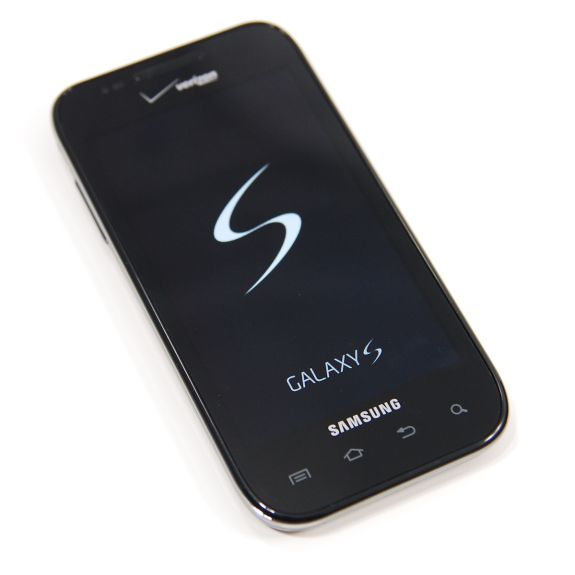
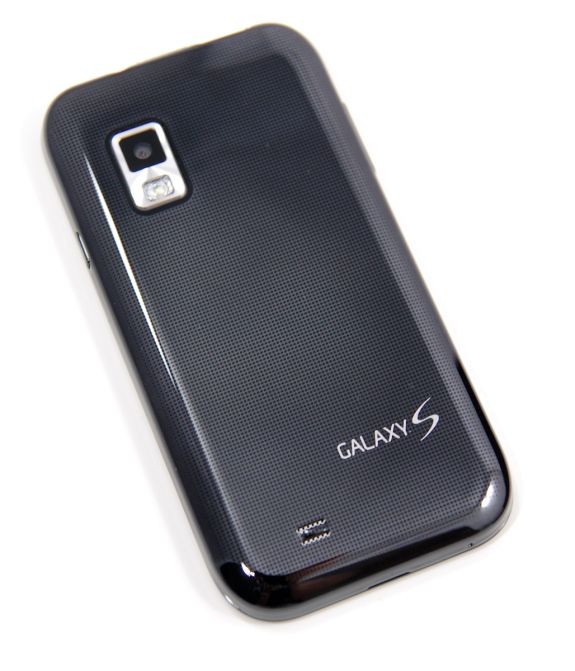
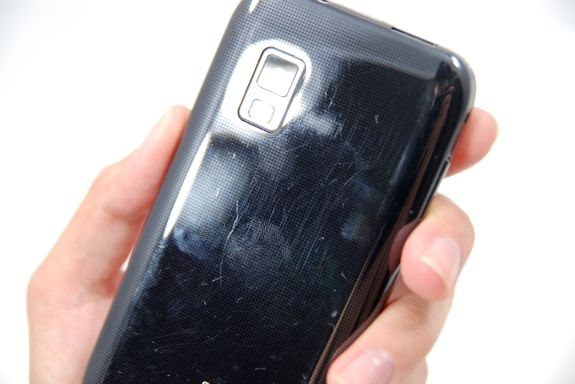
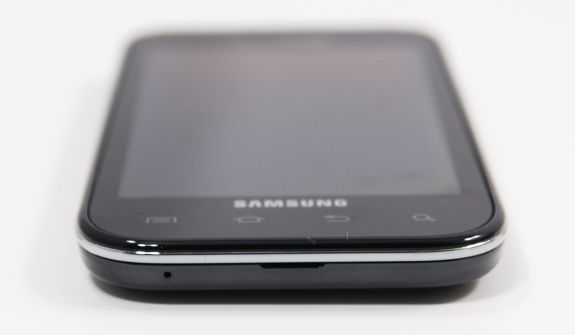
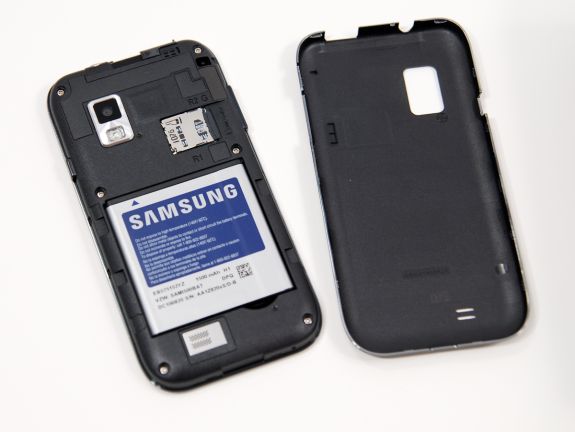
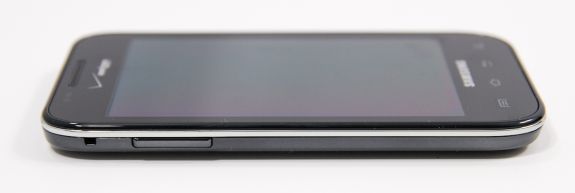

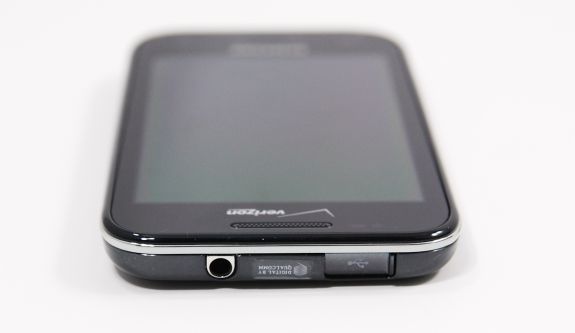

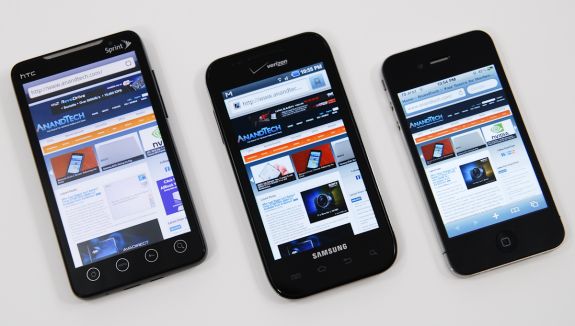
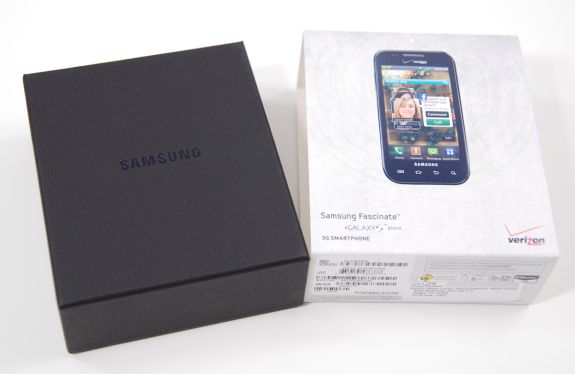








73 Comments
View All Comments
Ethaniel - Tuesday, October 5, 2010 - link
Good thing you directly recommend rooting and flashing the device. That Verizon-pseudo Google-Bing combo is kinda creepy... and bloated.medi01 - Tuesday, October 5, 2010 - link
"Outside readability in practice is improved from the Nexus One. "Dare I ask whether it is improved from, God forbid, iPhone 4? :rolleyes:
deputc26 - Tuesday, October 5, 2010 - link
In the performance page,Loading Engadget Times
EVO Should be 2.2 not 2.1.
Brian Klug - Tuesday, October 5, 2010 - link
I haven't included numbers from the EVO running 2.2 yet, although I've got them and will do so, those are current for 2.1 (as marked) ;)-Brian
Shlong - Tuesday, October 5, 2010 - link
it seems the Epic with Sprint is the best out of the Galaxy S line.alovell83 - Tuesday, October 5, 2010 - link
The Korean Galaxy S would beg to differ. FF cam + DMB. Yes, you do lose out on 4G, but you save hundreds on the life of the contract and it isn't as much up front either. Out of those available to the U.S. it's the $10 4G tax, without necessarily receiving a 4G signal which is the bummer, but you still get the best kit subsidized state-side. Living in a 4G city, the Epic is a no-brainer. Outside, we are talking about $300 more, assuming you don't get an amazon $.01 deal which would bump the contract life of the Epic to more than $400 more than the others...just for a FF camera and (cross you fingers, hopefully) to one day get a 4G signal in your city is just asking for too much.silverblue - Tuesday, October 5, 2010 - link
I have the UK version of the Galaxy S, and it's quite odd how many variants are out there. Differences on the UK version:1) no LED flash
2) sports an FF cam
3) the micro-SD slot is on the left inside the back, with the SIM card to the right and the built-in micro-SD above that
4) the buttons are confined to Menu on the left, Back on the right, and a physical Home key in the middle
5) the headphone socket has a black plastic surround instead of chrome effect (strangely, the review states 18mm - shouldn't that be 35mm?)
6) there's a "with Google™" logo on the back along with the SAMSUNG logo but no mention of Galaxy S; there's no mention of the carrier.
7) the phone weighs less at 118g
8) The default wallpaper isn't a Live one
deputc26 - Tuesday, October 5, 2010 - link
Interesting and yes that should be 35mmBrian Klug - Tuesday, October 5, 2010 - link
Yeah, I meant 3.5mm, 1/8 inches. Fixed ;)-Brian
chemist1 - Tuesday, October 5, 2010 - link
The single most important function of a phone is to, well, be a phone, i.e., do voice communication. And one of the characteristics most important to voice communication is the audio quality---both sending and receiving (via the earpiece or a headset; the percent of time spent listening via speakerphone is, for most, is less than for the earpiece or a headset). Yet, in a very long and otherwise thorough review, I could find only one sentence that addressed earpiece audio quality:"Earpiece performance and volume is adequate - voice quality is as good on the Fascinate as I've seen on other CDMA handsets in the testing I performed."
And I could find no mention of audio quality from the headset jack, nor any mention of audio quality for someone on the receiving end of a call from this phone.
It's sort of like reading a detailed review of a new camera, in which lots of attention is given to metering, focus, etc. (all parameters that affect image quality), but with only a single sentence on how good the images are after metering, focus, etc. is dialed in. Likewise, you have several paragraphs on issues that affect audio quality -- e.g., the dependence of signal attenuation on how the phone is held-- but again, only one sentence on how good the phone actually sounds (and nothing on how good I sound to someone I'm calling) after these secondary effects are taken care of. I.e., suppose I'm receiving a call under ideal conditions (say, it's from a land line, there's a strong signal, I am holding the phone optimally, etc.). In that case, do you mean to tell me that someone with a trained ear would hear no difference in audio quality when listening through the earpieces of different CDMA handsets? While this may be true, I certainly would not be convinced of that based on reading just your one sentence, since it does not give the impression that a serious attempt to assess audio quality has been made.
As you can likely tell, I'd like to strongly suggest that, in future reviews, the comparative audio quality of these phones is addressed in a more serious and discriminating manner, by someone with extensive audio expertise and a highly trained ear. The reason your site is so well-respected is because it brings an unusual level of sophistication to computer hardware reviews. I’d like to see that same sophistication applied to audio performance, when you are reviewing devices where audio performance should be central (phones and portable music players).
I've been following this site for many years, and I think you folks are the best --- you do a fantastic job. But your expertise is computers, it's not audio. And often, when you venture into audio, I don't see it approached it with the level of sophistication with which you approach computer hardware. You can see your site's extraordinary sophistication with computer hardware with, for instance, Anand's perspicacious reviews of SSDs, in which he identified 4K random read and write speeds (as opposed to sequential large-block performance) as being the key to real-world performance. Yet, by contrast, when Anand was reviewing the audio perfomance of the iPod Nano, he just cookbooked the standard set of Rightmark Audio Analyzer measurements (http://www.anandtech.com/show/3903/apples-ipod-tou... he didn't demonstrate the audio expertise to first listen, and then make an informed decision of which measurements needed to be done. If he had, he might have realized that problems lie in areas that would only be revealed by a different set of measurements. Anand then went on to say "I believe we've hit a ceiling for PMP audio playback quality." Well, no, it could still be improved quite a bit. It is informative to contrast how Anand approached audio with, for instance, Marc Heijligers' astute analysis of iPod audio performance, at: http://homepage.mac.com/marc.heijligers/audio/ipod...
[I did mention this in the comments for Anand’s review, but it was towards the end of the thread, so they may not have been noticed.]
I suspect that, if you want the audio component of your reviews to be up to the high level of sophistication you show for computer hardware, you're going to need to bring in someone with years of audio expertise and a highly trained ear.
Thanks for listening to this very long comment!